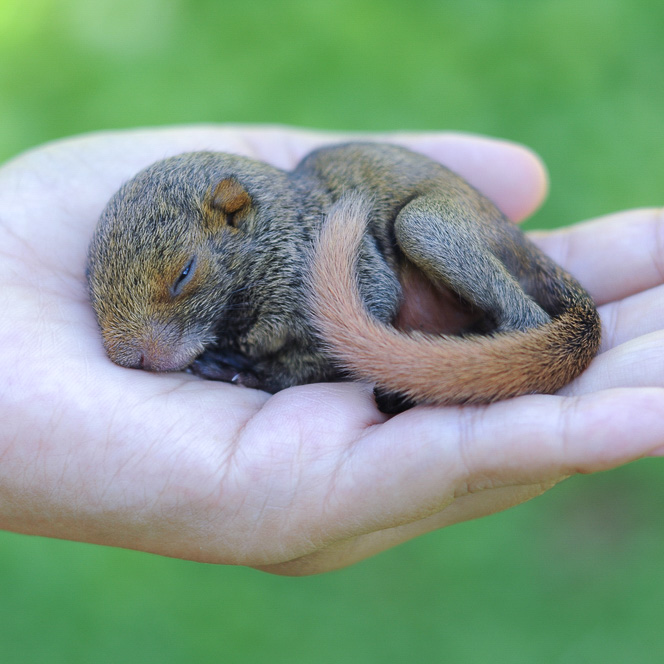
How to Care for a Wild Baby Squirrel
Introduction
Wild baby squirrels are fragile creatures that require specialized care to survive. If you find a baby squirrel that has been orphaned or injured, it is important to take immediate action to ensure its well-being. This comprehensive guide will provide you with detailed instructions on how to properly care for a wild baby squirrel, including feeding, housing, and socialization.
Assessing the Situation
Before handling the baby squirrel, it is crucial to assess the situation and determine if intervention is necessary. Observe the squirrel from a distance to see if its mother is nearby. If the mother is present, it is best to leave the baby alone, as she will provide the necessary care.
If the mother is not present or the baby is injured, it is important to intervene. Carefully approach the baby and gently pick it up using a soft cloth or towel. Avoid handling the baby with bare hands, as this can transfer human scent and potentially deter the mother from returning.
Feeding
Feeding a wild baby squirrel is a critical aspect of its care. Baby squirrels require a specialized formula that mimics their mother’s milk. This formula can be purchased at pet stores or online.
Preparing the Formula
To prepare the formula, follow the instructions on the package carefully. Use warm water (around 100°F) and mix the powder thoroughly. Do not overmix, as this can create air bubbles that can cause digestive problems.
Feeding the Baby
Feed the baby squirrel every 2-3 hours using a syringe or a small bottle with a nipple. Hold the baby upright and gently insert the syringe or nipple into its mouth. Do not force the baby to eat, and stop feeding if it resists.
Frequency and Amount
The amount and frequency of feeding will vary depending on the age and size of the baby squirrel. As a general guideline, feed the baby:
- 1-2 weeks old: 2-3 ml of formula every 2-3 hours
- 3-4 weeks old: 3-4 ml of formula every 3-4 hours
- 5-6 weeks old: 4-5 ml of formula every 4-5 hours
Housing
Baby squirrels require a warm and secure environment to thrive. Provide a small box or cage lined with soft bedding, such as fleece or towels. Place a heating pad or hot water bottle wrapped in a towel at one end of the enclosure to create a warm spot for the baby.
Temperature
Baby squirrels are unable to regulate their own body temperature, so it is essential to maintain a warm environment. The ideal temperature for a baby squirrel is between 85-95°F. Use a thermometer to monitor the temperature and adjust the heating source accordingly.
Cleanliness
Keep the baby squirrel’s enclosure clean to prevent infection. Change the bedding daily and clean the enclosure thoroughly with a mild disinfectant once a week.
Socialization
Socialization is an important aspect of caring for a wild baby squirrel. While it is not necessary to handle the baby excessively, it is beneficial to spend time talking to it and gently petting it. This will help the baby become accustomed to human interaction and reduce its fear of humans.
Rehabilitation
Once the baby squirrel is old enough, it will need to be rehabilitated and released back into the wild. This process should be done gradually to ensure the squirrel’s survival.
Preparing for Release
Start by providing the squirrel with access to an outdoor enclosure where it can practice climbing and foraging. Gradually increase the amount of time the squirrel spends outdoors and reduce the amount of formula it receives.
Release
When the squirrel is fully weaned and has demonstrated the ability to forage and climb, it is ready to be released. Choose a safe location with plenty of trees and food sources. Place the squirrel in a tree and observe it from a distance to ensure it is able to fend for itself.
Additional Tips
- Do not give the baby squirrel cow’s milk or other human foods, as these can cause digestive problems.
- If the baby squirrel is not eating or appears lethargic, contact a veterinarian immediately.
- Wear gloves when handling the baby squirrel to prevent the spread of disease.
- Be patient and provide the baby squirrel with a loving and supportive environment.
Conclusion
Caring for a wild baby squirrel is a rewarding experience that requires patience, dedication, and specialized knowledge. By following the instructions outlined in this guide, you can provide the baby squirrel with the care it needs to survive and thrive. Remember, the ultimate goal is to rehabilitate the squirrel and release it back into its natural habitat.
